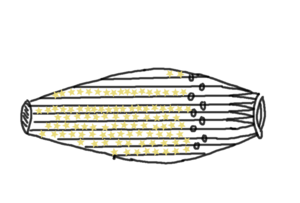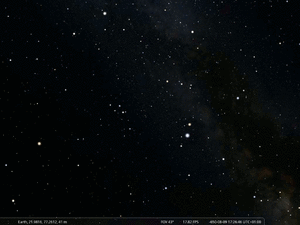Dhanishta: Difference between revisions
No edit summary |
No edit summary |
||
| (4 intermediate revisions by the same user not shown) | |||
| Line 1: | Line 1: | ||
{{DISPLAYTITLE:}} |
{{DISPLAYTITLE: Dhaniṣṭhā (श्रविष्ठा)}} |
||
[[File:23 |
[[File:23 Dhanishta draw.png|thumb|Dhanishta is the 23rd nakshatra.]] |
||
[[File:22+23 nakshatra stellarium.gif|thumb|The 22nd and 23rd nakshatra mapped to the star chart at Aquila and Delphinus. Dhanishta is the eastern (left) one. ]] |
[[File:22+23 nakshatra stellarium.gif|thumb|The 22nd and 23rd nakshatra mapped to the star chart at Aquila and Delphinus. Dhanishta is the eastern (left) one. ]] |
||
Dhaniṣṭhā (श्रविष्ठा), "most famous", is an Indian name, used by the Indian Vedic tradition. Most of these names are roughly 3000 years old. They pre-date Hinduism but were taken over by it. |
|||
==Etymology and History== |
==Etymology and History== |
||
'''Name Variants''' |
|||
| ⚫ | |||
* Dhaniṣṭhā |
|||
* Dhanishta |
|||
* Vāsava, |
|||
* Vasubha, |
|||
* Śraviṣṭhā ("the swiftest") |
|||
| ⚫ | |||
The term "dhanishta" literally means "most famous" which may refer to the recognizable shape of stars of Delphinus that are identified here. An laternative name is Shravishthā, "swiftest". |
The term "dhanishta" literally means "most famous" which may refer to the recognizable shape of stars of Delphinus that are identified here. An laternative name is Shravishthā, "swiftest". |
||
Its depiction in temples displays a huge jar containing exactly 100 small stars, likely symbolizing the stream of the Milky Way next to the asterism in [[Delphinus]] with which the jar-like form perfectly and recognizably matches. For whatever reason (not given here) here are exactly 100 stars in the jar (neighbouring the "100 physicians"-asterism [[Satabhisa|Shatabhisa]] in the sky) and they are only inside the jar. This contrasts the depiction of [[Revati]] which is a jar with fewer star among which two are outside of the jar. |
|||
The depiction of feet at that place is confusing as the asterisms of the "blessed feet" are the nakshatras 25 and 26 which would also much better match the pattern, as they form two parallel lines. We suspect some confusion here. |
|||
The standard identification is the group of the brightest stars in Delphinus: α, β, γ, δ Delphini |
|||
| ⚫ | |||
| ⚫ | |||
== Mythology == |
|||
| ⚫ | |||
== |
==Mythology== |
||
| ⚫ | |||
==Weblinks== |
|||
| ⚫ | |||
| ⚫ | |||
| ⚫ | |||
==References== |
|||
| ⚫ | |||
[[Category:Indian]] |
|||
[[Category:Indian]] [[Category:Asterism]] [[Category:Constellation]][[Category:Eurasia]][[Category:South Asian]] |
|||
[[Category:Asterism]] |
|||
[[Category:Constellation]] |
|||
[[Category:Eurasia]] |
|||
[[Category:South Asian]] |
|||
Latest revision as of 06:45, 14 October 2025
Dhaniṣṭhā (श्रविष्ठा), "most famous", is an Indian name, used by the Indian Vedic tradition. Most of these names are roughly 3000 years old. They pre-date Hinduism but were taken over by it.
Etymology and History
Name Variants
- Dhaniṣṭhā
- Dhanishta
- Vāsava,
- Vasubha,
- Śraviṣṭhā ("the swiftest")
Origin of Constellation
The term "dhanishta" literally means "most famous" which may refer to the recognizable shape of stars of Delphinus that are identified here. An laternative name is Shravishthā, "swiftest".
Its depiction in temples displays a huge jar containing exactly 100 small stars, likely symbolizing the stream of the Milky Way next to the asterism in Delphinus with which the jar-like form perfectly and recognizably matches. For whatever reason (not given here) here are exactly 100 stars in the jar (neighbouring the "100 physicians"-asterism Shatabhisa in the sky) and they are only inside the jar. This contrasts the depiction of Revati (रेवती) which is a jar with fewer star among which two are outside of the jar.
The standard identification is the group of the brightest stars in Delphinus: α, β, γ, δ Delphini
Transfer and Transformation of the Constellation
Mythology
mnemonic tales and cultural significance
Weblinks
References
- References (general)






